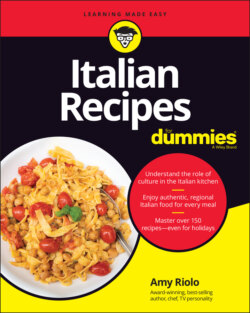Читать книгу Italian Recipes For Dummies - Amy Riolo - Страница 17
Appreciating How History and Geography Shaped Italian Cuisine
ОглавлениеItalians take cuisine very seriously while enjoying it to the fullest. In addition to mere fuel for the body, food is viewed as a source of daily pleasure and culinary medicine that should be savored. Along with fashion, music, art, architecture, design, and other artisan crafts, authentic cooking and food products are important parts of the culture that are a source of pride for Italians. Italians believe that the more informed we are on where our food comes from (both in the historical and geographical sense), the more we will appreciate it and enjoy it. In addition, understanding the history behind a dish helps to preserve its place in history by creating a place for it on the culinary landscape that won’t soon be forgotten. Taking the time to learn about Italian history and the unique features of its geography gives you the knowledge needed to serve the proper dishes at the right time of day and during the right season. It also enables you to pair foods together more easily and get the most out of seasonal produce. In short, knowledge of Italian history and geography helps to give you the mindset that an Italian naturally brings to the kitchen.
What Italians consider to be their cuisine varies greatly from how others around the world describe it. True Italian cuisine is recognized as the regional foods and recipes that make up the traditional classics that have been enjoyed for decades, centuries, and even millennia. There are a few ubiquitous and world-renowned creations that Italians claim as their collective own, such as pizza, pasta, risotto, gelato, and panettone. In the modern world, those recipes are carefully guarded, protected, and considered to be part of the culinary patrimony of the nation. These edible ambassadors make Italians proud when they are successfully recreated around the globe.
If you scratch a bit deeper beyond the surface, however, you will note that each of those dishes is linked to a particular place, such as the pizza of Naples, or they come from a larger category, such as pasta, which has different regional variations. Italians describe their own food by region, town, or city. Ragù Bolognese (from Bologna), Torta Caprese (from Capri), Carciofi all Romana (from Rome), and so on. As a result, to truly understand Italian cuisine, you must learn about Italy’s regions, culture, and history.
Food in every Italian region is the most highly celebrated aspect of the culture. Appreciated for being a daily source of pleasure, joy, and health, Italian food is a way of life. Chapter 2 discusses how time-honored traditions in agriculture and in cooking have woven their way into the tapestry of Italian daily life. By reading that chapter, you get a better sense of the role that food plays, beyond fuel, in an Italian’s life. By learning about highlights in Italian culinary history, you quickly can identify how the cuisines of various regions have both common denominators and unique qualities.
Regardless of which Italian region you spend time in, you’ll be able to taste the layers of history that it has experienced. From ancient indigenous inhabitants, to foreign rulers, and fancy courts, many factors have contributed to make Italian cuisine a microcosm of the influences that have shaped the course of Mediterranean history. The mere notion of food as culture itself has, for centuries, enhanced Italian cuisine and enabled it to become the most popular cuisine in both the world and the United States today.
Many newcomers to “real” Italian cuisine from abroad are surprised to learn that some of their favorites — which may have been Italian-American dishes or just improperly prepared recipes — are actually not part of a true Italian repertoire. Others still are surprised to learn just how simple, straightforward, mouthwatering, and healthful Italian food can be.
In the United States, only one-third of the Italian foods eaten actually come from Italy. The rest are either falsely advertised or adaptations. In many cases, even the foods that are imported from Italy are not prepared properly. For this reason, many Italian recipes have disciplinari, or production guidelines, on the ways in which they should be made correctly. Pesto sauce from Genoa and pizza from Napoli are two examples of such recipes.
